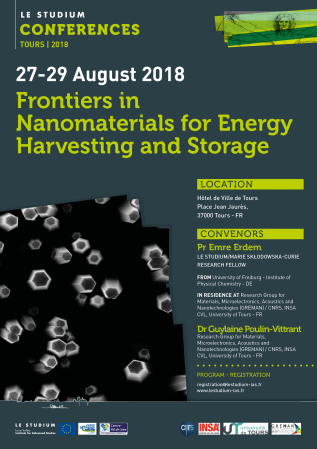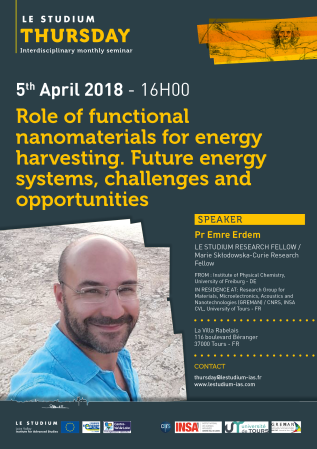Prof. Emre Erdem

From
University of Freiburg - Institute of Physical Chemistry - DE
In residence at
Research Group for Materials, Microelectronics, Acoustics and Nanotechnologies (GREMAN) / CNRS, INSA CVL, University of Tours - FR
Host scientist
Dr Guylaine Poulin-Vittrant
PROJECT
Investigation of intrinsic and extrinsic defect centers of ZNO Nanowires for Nano-Generators
For efficient and successful mechanical energy harvesting, a configuration that has garnered much focus in recent research is the piezoelectric nanogenerator. The concept of the nanogenerator has shown potential for harvesting energy from the ambient environment to power systems. Kinetic energy harvesting nanogenerators based on the piezoelectric properties of ZnO nanowires have attracted much interest. In this proposal, we will fabricate hydrothermally synthesized ZnO nanowire-based nanogenerators in order to control the average diameter of wires and also the quality of wires alignment. Intrinsic point defects as well as extrinsic defects introduced via doping of transition metal ions by no doubt play a crucial role not only on the amplitude of generated voltage signal from nanogenerators but also on the conductivity of ZnO. Despite its advantages, the lack of fundamental knowledge about intrinsic defects and doping ions presents an obstacle to the development of practical devices such as nanogenerators which requires low conductivity for high performance. The difficulty to make reliable ZnO nanowire based nanogenerators is closely related to the intrinsic and extrinsic defects specifically interstitials, vacancies and metal ions (i.e., Mn, Fe). The proposed research will provide a fundamental understanding of defects in ZnO that could lead to reliable devices using the peculiarity of nanogenerators. The results of electronic (electron paramagnetic resonance spectroscopy), optical (photoluminescence spectroscopy) and electrical (impedance spectroscopy) characterization investigations could give the basis for the industrial and economic manufacturing of ZnO nanowires. This project will provide physical understanding of the defect structures in nanoscale wire form of ZnO.
Publications
Final reports
For efficient and successful mechanical energy harvesting, a configuration that has garnered much focus in recent research is the piezoelectric nanogenerator. The concept of the nanogenerator has shown potential for harvesting energy from the ambient environment to power systems. Kinetic energy harvesting nanogenrators based on the piezoelectric properties of ZnO nanowires have attracted much interest. The aim of this work is to fabricate hydrothermally synthesized ZnO nanowire-based nanogenerators in order to control the average diameter of wires and also the quality of wire alignment. Intrinsic point defects as well as extrinsic defects introduced via doping of transition metal ions by no doubt play a crucial role not only the amplitude of generated voltage signal from nanogenerators but also the conductivity of ZnO. Despite its advantages, the lack of fundamental knowledge about intrinsic defects and doping ions presents an obstacle to the development of practical devices such as nanogenerators which requires high conductivity for high performance. The difficulty to make reliable ZnO nanowire based nanogenerators is closely related to the intrinsic and extrinsic defects specifically interstitials, vacancies and metal ions (i.e., Mn, Fe). This research provides a fundamental understanding of defects in ZnO that could lead to reliable devices using the peculiarity of nanogenerator. The results of electronic (electron paramagnetic resonance spectroscopy), optical (photoluminescence spectroscopy) and electrical (impedance spectroscopy) characterization investigations could give the basis for the industrial and economic manufacturing of ZnO nanowires. This work provides physical understanding of the defect structures in nanoscale wire form of ZnO.



